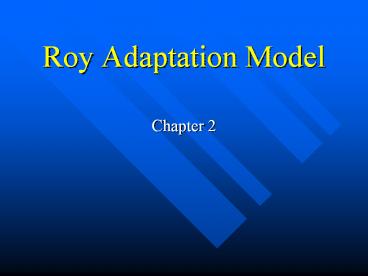Roy Adaptation Model - PowerPoint PPT Presentation
1 / 37
Title:
Roy Adaptation Model
Description:
Roy Adaptation Model. Chapter 2. Discuss ... Based on assumptions of Helson's Adaptation-Level theory. Humanism. Humanism ... Humanism. Veritivity. Veritivity ... – PowerPoint PPT presentation
Number of Views:2750
Avg rating:3.0/5.0
Title: Roy Adaptation Model
1
Roy Adaptation Model
- Chapter 2
2
Discuss the relationship of systems theory to Roy
Model.
- Based on assumptions of von Bertalanffys General
Systems Theory - Based on assumptions of Helsons Adaptation-Level
theory - Humanism
3
Humanism
- Philosophy and psychology that recognizes the
person and subjective dimensions of the human
experience as central to knowing and valuing.
4
Discuss the relationship of systems theory to Roy
Model.
- Based on assumptions of von Bertalanffys General
Systems Theory - Based on assumptions of Helsons Adaptation-Level
theory - Humanism
- Veritivity
5
Veritivity
- Principle of human nature that affirms a common
purposefulness of human existence, activity and
reactivity for the common good and value and
meaning of life.
6
Discuss the concepts of adaptation model.
- Adaptive Human system has the capacity to
adjust effectively to changes in the environment
and affects the environment.Promote survival,
growth, reproduction mastery.
7
System
- Set of parts connected to function as a whole for
some purpose and through the interdependence of
the parts. Input--Through put--Output--Feedback
8
Adaptive Level
- Changing Point influenced by the demands of the
situation and the persons internal resources,
including capabilities hopes, dreams,
aspirations, motivations. - Represents the persons ability to respond.
9
Adaptive Level
- The response (output) or behavior is a function
of the input stimuli and the adaptation level. - It is adaptive or ineffective.
10
Identify the environment as a significant concept
of adaptation.
- Stimuli are environmental influences.
- 3 type focal contextual, or residual.
11
Focal Stimuli
- Internal or external stimulus most immediately
confronting the person
12
Contextual Stimuli
- All other stimuli present that contribute to the
focal stimuli. - Influence how the person can deal with the focal
stimulus.
13
Contextual Stimuli
14
Residual Stimuli
- Factors whose effect in the current situation is
unclear. - No clear data.
- Based on theory or experience of the nurse.
15
Residual Stimuli
?
?
?
?
?
?
16
Coping Mechanisms
- Innate or acquired ways of responding to the
changing environment. - Innate are genetically determined or common to
the species and automatic processes. - Acquired are developed through learning and other
process.
17
Coping Mechanisms
- Regulator
18
Regulator Subsystem
- Automatic responses through neural, chemical and
endocrine coping processes.
19
Coping Mechanisms
- Regulator
- Cognator
20
Cognator Subsystem
- Perceptual/information processing, learning,
judgment, and emotion
21
Perceptual/information Processing Examples
- Selective Attention
- Coding
- Memory
22
Learning
- Imitation
- Reinforcement
- Insight
23
Emotion
- Defenses are used to seek relief from anxiety
24
Emotion
- Make affective appraisal and attachments.
25
Identify the modes submodes of the Roy
Adaptation Model
- Adaptive Modes--Behaviors
- Physiological
- Self-concept
- Role function
- Interdependence
26
Physiological-Physical ModeNeeds of
physiological integrity
- Oxygenation
- Nutrition
- Elimination
- Activity Rest
- Protection
- Senses
- Fluid, electrolyte, and Acid-Base Balance
- Neurologic Function
- Endocrine Function
27
Self-Concept Mode
- Psychological and spiritual aspects of the
person. - Need for psychic integrity
28
Self-concept
- Composite of beliefs and feelings that a person
holds about him or herself at a given time.
29
Self Concept
- Physical Self
- Body Sensations
- Body Image
30
Self Concept
- Personal Self
- Self-consistency
- Self-ideal
- Moral-ethical-spiritual self
31
Role Function Mode
- Role is a set of expectations about another
- Need for social integrity
- Role classification Primary, Secondary, Tertiary
32
Role Function Behaviors
- Instrumental (task)
- Expressive (emotional)
33
Interdependence Mode
- Interactions related to the giving and receiving
of love, respect, and value. - Need is for affectional adequacy.
34
Interdependence Behaviors
- Receptive
- Contributive
35
Behaviors
- Adaptive
- Ineffective
36
Identify the goal of nursing according to Roy
- Promote ADAPTATION in each of the four modes.
37
Discuss the nursing activities in the Roy
Adaptation Model
- What affects adaptation behavior?
- Stimuli
- If you want to change behavior,change stimuli.































